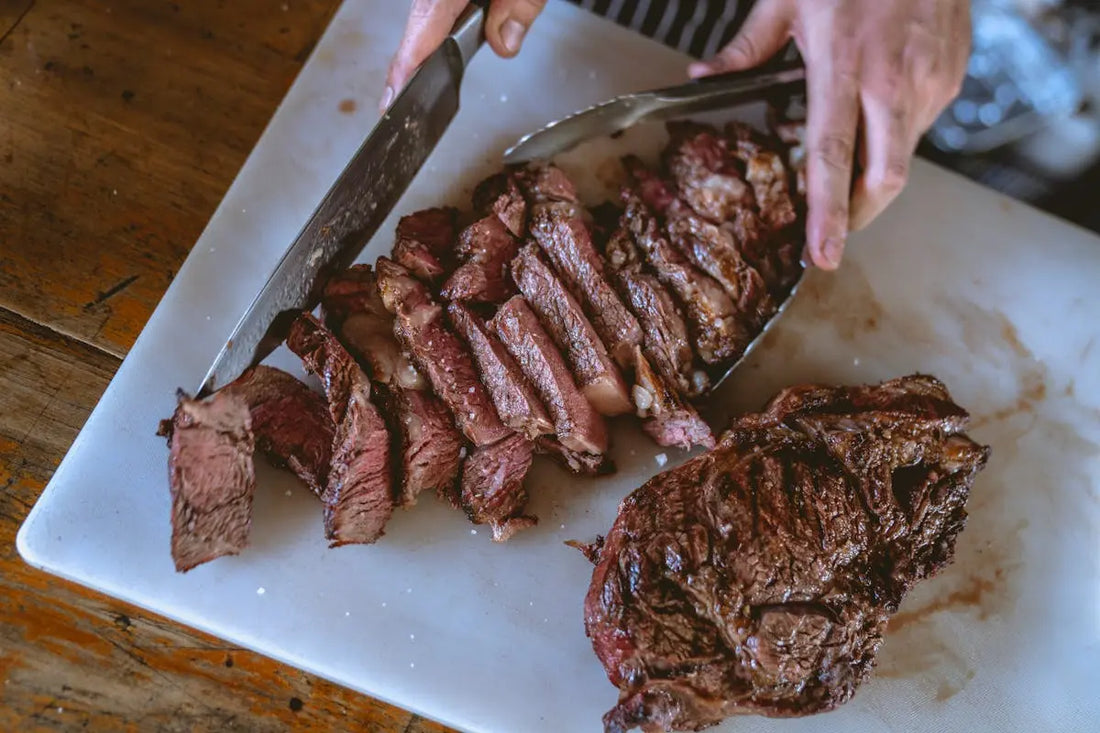
Ostrich Steaks: A Sustainable and Delicious Alternative to Beef
Share
Have you ever considered ostrich steaks as a centerpiece for your next dinner? Ostrich steak is the cornerstone where sustainability meets gourmet. Find out why this exotic alternative is gaining ground in the culinary scene.
Why Ostrich? Unpacking the Benefits
Ostrich farming marks a bold leap towards revolutionizing meat consumption, embedding sustainability at its core. Unlike traditional livestock, ostriches pose a lesser burden on our planet. This fascinating bird, predominantly farmed for its lean, rich red meat, demands less water, feed, and space. Consequently, ostrich farming casts a significantly smaller carbon footprint than its beef counterpart, nudging the environmentally conscious consumer towards a greener choice. Its sustainable nature is bolstered by the bird’s efficient feed conversion ratio, revealing why ostrich meat is heralded as a sustainable alternative to beef.
Transitioning to ostrich steaks is not just an environmental decision; it’s a nutritional upgrade. Ostrich meat sits on the throne of lean meats, boasting lower fat levels and higher protein content compared to traditional beef. Enriched with essential minerals and vitamins, it offers a guilt-free carnivorous experience. By integrating ostrich into your diet, you’re not only prioritizing the planet but also your health, making it a win-win scenario for the mindful eater.
Nutritional Value: A Comparison with Beef
The nutrition profile of ostrich steak impresses with its low-fat content, making it an ideal choice for those monitoring their dietary fat intake. A closer look reveals that ostrich meat is significantly leaner than beef, harboring fewer calories and saturated fats, while offering a comparable, if not superior, protein punch. This lean protein supports muscle growth and repair without the added guilt of excessive fat found in beef. The health benefits of switching to ostrich are undeniable, providing a healthy boost to any meal.
Apart from its low-fat allure, ostrich meat outshines beef with higher levels of iron and essential vitamins such as B12, pivotal for maintaining energy and overall health. This dense nutrient profile fills the gaps often found in modern diets, making ostrich not just an alternative, but a preferable option for the health-conscious.
Sustainable Farming: The Ostrich Difference
Diving deeper into sustainable farming, ostriches emerge as champions of environmental stewardship. Their hardy nature allows them to thrive in less fertile lands, minimizing deforestation and land degradation contrary to cattle farming, which is often linked to significant ecological imbalances. The reduced environmental impact of ostrich farming, from lower methane emissions to minimal water usage, underscores the potential of ostrich meat in carving pathways towards a sustainable dietary future.
Ostriches not only require less natural resources but their faster growth rate compared to cattle further accentuates their role in sustainable meat production. These attributes align perfectly with global efforts to mitigate food shortages, presenting ostrich farming as a viable solution to meet the world’s increasing protein demand without sacrificing the planet’s health.
Cooking 101: Tips for Perfect Ostrich Steaks
Cooking ostrich steaks to perfection begins with understanding this unique meat’s properties. Due to its low-fat content, ostrich meat cooks faster than beef, necessitating a keen eye to prevent overcooking, which could lead to a tougher steak. For the best experience, aim for medium-rare to medium doneness, allowing the steak to rest before slicing to retain its juices. Marinating your ostrich steak can enhance its natural flavors, offering a delightful taste adventure that rivals traditional steaks with every bite.
The versatility of ostrich meat opens up a world of culinary creativity, from grilling and roasting to slicing it up for stir-fries. Ostrich steaks can easily adapt to a variety of flavors and cooking styles, making it an exciting addition to your culinary repertoire. With expert tips and recipes, you’re well-equipped to explore the rich tastes ostrich meat has to offer.
From Farm to Table: Where to Source Your Steaks
The journey of ostrich meat from farm to table highlights the importance of sourcing from farms that adhere to sustainable and ethical practices. Superior Ostrich stands out as a beacon of responsible farming, ensuring that each ostrich is raised with care and respect. By choosing suppliers that prioritize animal welfare and environmental sustainability, consumers play an active role in supporting the agricultural sector’s shift towards more responsible meat production.
In today’s interconnected world, accessing premium ostrich meat has never been easier. Online platforms and specialty butchers offer a gateway to exploring this exquisite meat, bringing the unique flavors of ostrich directly to your dinner table. This convenience allows food enthusiasts to venture into new culinary territories, all while supporting a sustainable and ethical food chain.
Pairing Ideas: Enhancing Your Ostrich Experience
Pairing the right sides and wines with ostrich steaks can transform a simple meal into a gourmet dining experience. The meat’s rich, yet subtly gamey flavor complements a wide array of side dishes, from roasted vegetables to a fresh, zesty salad. When it comes to wine, a full-bodied red such as a Cabernet Sauvignon or a Shiraz can match the robustness of the steak, elevating the meal’s overall flavor profile.
For those seeking a lighter accompaniment, consider a vibrant Chardonnay or a crisp Sauvignon Blanc to contrast the steak’s richness. The versatility of ostrich meat also makes it an excellent candidate for exotic spice blends and marinades, inviting you to explore a world of flavor in every dish. Embracing ostrich steaks offers a delightful culinary journey, promising new tastes and combinations that challenge the conventional steak dinner.
Toward a Tastier, Greener Future
Embracing ostrich steaks isn’t just a step towards more adventurous eating; it’s a stride towards a sustainable and ethical food future. As consumers look for ways to reduce their environmental footprint without sacrificing taste, ostrich emerges as a viable, delicious option. Whether seared, grilled, or roasted, adding ostrich to your dietary repertoire promises a flavorful journey with a lighter impact on our planet. Discover new culinary adventures and prioritize your health with superior ostrich products today.
